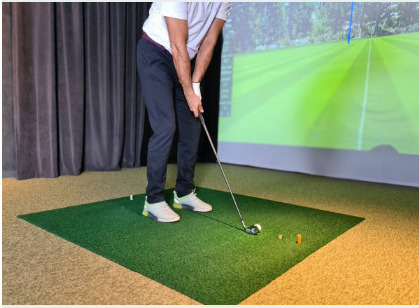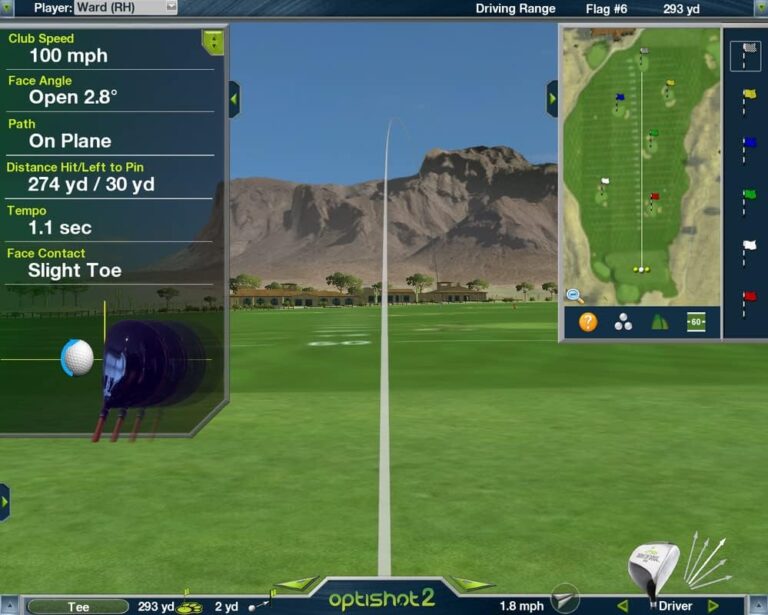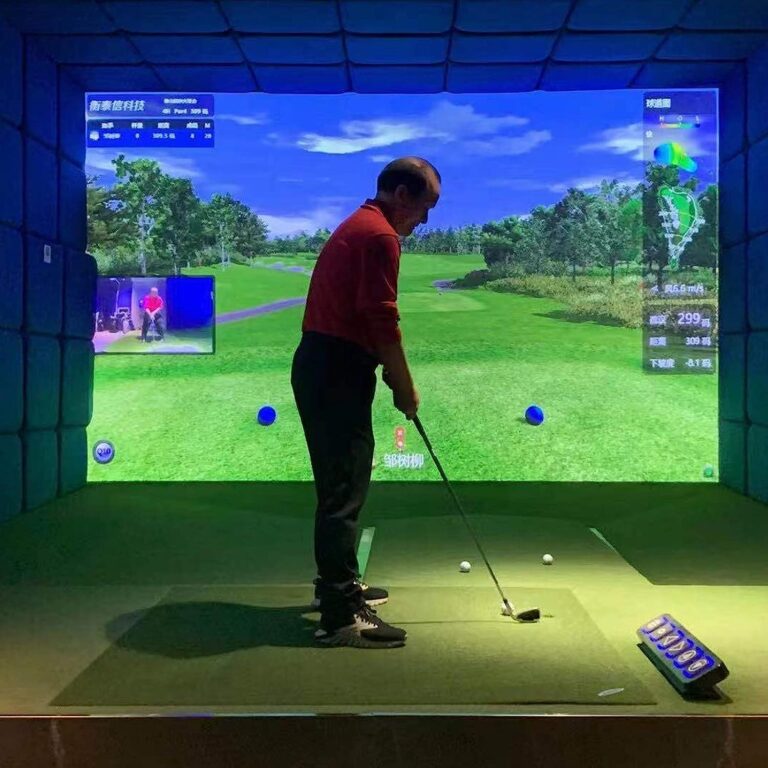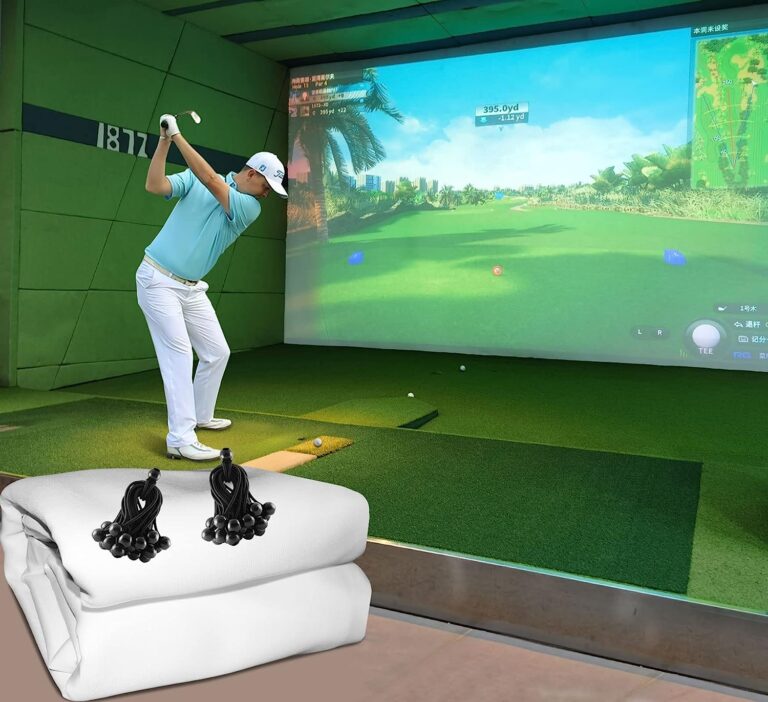What is a Golf Simulator?
A golf simulator is a device that allows you to play or practice golf indoors or outdoors by simulating the real-life conditions of a golf course. A golf simulator typically consists of four main components:
- A launch monitor or tracking system that measures the speed, spin, launch angle, and direction of your golf shots.
- A net or impact screen that catches your golf balls and displays the simulated ball flight.
- A projector that projects the virtual golf course or range onto the screen.
- Software that simulates your shots and provides feedback, statistics, and various game modes.
Benefits of Using a Golf Simulator
Using a golf simulator can have many benefits for golfers of all skill levels, such as:
- You can play or practice golf anytime, anywhere, regardless of the weather or daylight conditions.
- You can improve your swing and technique by getting instant feedback and analysis on your shots.
- You can play on hundreds of different courses from around the world, including famous ones like Pebble Beach and St. Andrews.
- You can have fun and challenge yourself with various game modes, such as closest to the pin, longest drive, stroke play and match play.
- You can save time and money by avoiding travel, green fees and equipment rental.
How to Choose the Best Golf Simulator for Your Needs
There are many factors to consider when choosing the best golf simulator for your needs, such as:
Your budget: Golf simulators can range from a few hundred dollars to tens of thousands of dollars, depending on the quality, features and performance of the components. You should set a realistic budget that matches your expectations and goals.
Your space: Golf simulators require enough space to accommodate the components and your swing and stance. You should measure your available space and check the dimensions of the simulator before buying. You should also consider the lighting, noise and ventilation of your space.
Your preferences: Golf simulators vary in their accuracy, realism, functionality and user-friendliness. You should decide what aspects are most important to you, such as club data, ball data, course selection, game modes, graphics, ease of use and customer service.
3 of the best Golf Simulators of 2023
Based on our research and reviews, here are 3 of the best golf simulators of 2023 that you can buy:
SkyTrak Plus SIG10 Golf Simulator Package: This package features the SkyTrak Plus launch monitor, which is an upgraded version of the original SkyTrak that offers club data, faster processing, improved outdoor performance and additional courses.
The package also includes a SIG10 impact screen, a projector, a mat and a software subscription. This package is ideal for those who want a balance between affordability, power, quality and performance.
Uneekor SimKit – EYE XO Simulator: This package features the Uneekor EYE XO launch monitor, which is a dual-camera system that tracks both ball and club data with high accuracy and speed.
The package also includes a SimKit enclosure with an impact screen, a projector mount and a hitting mat. This package is ideal for those who want a premium photometric system that offers detailed feedback and analysis.
Garmin Approach R10: This device is a compact and portable launch monitor that tracks ball speed, clubhead speed, smash factor, swing tempo and more. It also connects to your smartphone or tablet via Bluetooth and allows you to play on more than 42,000 courses with stunning graphics.
This device is ideal for those who want a simple and versatile device that can be used indoors or outdoors.
What is the difference between a golf simulator and a launch monitor?
The main difference between a golf simulator and a launch monitor is that a launch monitor provides numerical data related to your shots, while a golf simulator is an entire system that not only measures data but also simulates your ball flight in a virtual software environment.
Golf simulators use a launch monitor to determine how far the ball would have gone if you were on a real golf course.
Some of the other differences and similarities between golf simulators and launch monitors are:
Launch monitors are usually more portable and user-friendly than golf simulators, as they are often smaller and lighter devices that can be connected to your smartphone or tablet via Bluetooth. However, some launch monitors are ceiling-mounted and require more space and installation.
Launch monitors work well with iOS and Android devices, as they often have companion apps that allow you to control them and view your shot data. Some launch monitors, such as the Garmin Approach R10, require an app to be used, as they do not have an electronic display on the unit itself.
Launch monitors provide accurate measurements of various parameters related to your club and ball at impact, such as carry distance, spin, ball speed, club head speed, smash factor, and swing tempo. Some launch monitors also provide club data, such as face angle, path angle, and attack angle.
Golf simulators use different software technologies to simulate the playing conditions of the course. The best simulators have the latest 3D technology that allows users to experience a virtual reality similar to what they experience at the actual course. Golf simulators also offer various game modes, such as closest to the pin, longest drive, stroke play, and match play.
Golf simulators require more components than launch monitors, such as a net or impact screen, a projector, a computer and a mat. Golf simulators also require more space and budget than launch monitors, as they are larger and more expensive systems.
The main purpose of a launch monitor is to provide numerical shot data, while the main purpose of a golf simulator is to simulate your shots with software. Launch monitors are a great option if you have a smaller budget or space, or if you want to focus on improving your swing and technique.
Golf simulators are a great option if you have a larger budget or space, or if you want to have fun and play on different courses.
Can I use a golf simulator for putting practice?
Yes, you can use a golf simulator for putting practice, but not all golf simulators are equally good at it. Some golf simulators are designed specifically for putting, while others have more features and functions for full swing shots.
Depending on your budget, space and preferences, you may want to choose a golf simulator that suits your putting needs.
Some of the best golf simulators for putting are:
Exputt RG Real-Time Putting Simulator: This is a device that is exclusively dedicated to putting practice. It uses a high-speed camera and innovative tracking software to track your swing mechanics and ball movement. It also simulates various weather conditions, green speeds, slopes and breaks.
You can practice on different courses, play online with other players, or explore different hole positions. This device is very affordable, easy to set up and simple to use.
FlightScope X3 PerfectBay Golf Simulator Package: This is a package that features the FlightScope X3 launch monitor, which is a radar-based system that tracks both ball and club data with high accuracy and speed. It also includes a PerfectBay enclosure with an impact screen, a projector mount and a hitting mat.
This package is ideal for those who want a premium radar system that offers detailed feedback and analysis for both full swing and putting shots.
Foresight Sports GCQuad SIG10 Golf Simulator Package: This is a package that features the Foresight Sports GCQuad launch monitor, which is a quad-camera system that tracks both ball and club data with high accuracy and speed. It also includes a SIG10 impact screen, a projector, a mat and a software subscription.
This package is ideal for those who want a premium photometric system that offers detailed feedback and analysis for both full swing and putting shots.
How much does a good golf simulator cost?
A good golf simulator can cost anywhere from a few hundred dollars to tens of thousands of dollars, depending on the quality, features and performance of the components. Golf simulators can be divided into three price categories: entry-level, mid-range and high-end.
Some of the factors that affect the cost of a golf simulator are:
The type of launch monitor or tracking system that measures the speed, spin, launch angle and direction of your golf shots. There are different technologies, such as radar, camera and infrared, that vary in accuracy, speed and reliability. Radar-based systems tend to be more expensive than camera-based systems, but they also offer more data and functionality.
The size and quality of the net or impact screen that catches your golf balls and displays the simulated ball flight. Larger and more durable screens can cost more than smaller and less durable ones, but they also offer a better visual experience and protection.
The quality and resolution of the projector that projects the virtual golf course or range onto the screen. Higher-end projectors can offer brighter and sharper images, but they also consume more power and generate more heat.
The software that simulates your shots and provides feedback, statistics and various game modes. Different software packages can offer different features, such as course selection, graphics, realism, user-friendliness, and customer service. Some software packages require a subscription fee, while others are included in the price of the launch monitor.
The accessories that enhance your golf simulator experience, such as mats, sensors, cameras, speakers, computers and tablets. These accessories can add to the cost of your golf simulator, but they can also improve your comfort, convenience and enjoyment.
Here are some examples of golf simulators in different price ranges:
Entry-level: These are golf simulators that cost less than $5,000. They usually have basic features and functions, such as a portable launch monitor, a small screen or a smartphone app, and a limited software package. They are suitable for casual golfers who want to have some fun or practice occasionally. Some examples are: Garmin Approach R10 ($600), Phigolf Home Golf Simulator ($250), Rapsodo Mobile Launch Monitor ($500).
Mid-range: These are golf simulators that cost between $5,000 and $15,000. They usually have more advanced features and functions, such as a more accurate launch monitor, a larger screen or a projector, and a more comprehensive software package.
They are suitable for serious golfers who want to improve their game or play regularly. Some examples are: SkyTrak Launch Monitor ($2,000), FlightScope Mevo+ ($2,000), Uneekor EYE XO ($10,000).
High-end: These are golf simulators that cost more than $15,000. They usually have the most sophisticated features and functions, such as a premium launch monitor, a huge screen or an enclosure, and a state-of-the-art software package.
They are suitable for professional golfers or enthusiasts who want to have the best possible golf simulator experience. Some examples are: TrackMan Golf Simulator ($21,000-$100,000), HD Golf Simulator ($35,000-$70,000), Foresight Sports GCQuad SIG10 Golf Simulator Package ($20,000).




